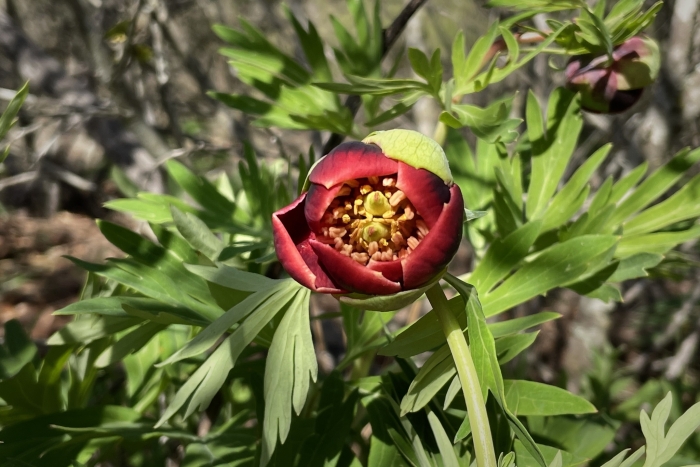California Peony
(Paeonia californica)
California Peony (Paeonia californica)
/
/

Madeleine Claire
CC BY 4.0
Image By:
Madeleine Claire
Recorded By:
Copyright:
CC BY 4.0
Copyright Notice:
Photo by: Madeleine Claire | License Type: CC BY 4.0 | License URL: http://creativecommons.org/licenses/by/4.0/ | Rights Holder: Madeleine Claire | Publisher: iNaturalist | Date Created: 2021-03-21T05:12:10Z |





















































Estimated Native Range
Summary
Paeonia californica, commonly known as California Peony, is a deciduous perennial herb that is endemic to the chaparral and woodland regions of California and Northwestern Mexico. It typically grows to a height of 35–70 cm and exhibits a seasonal life cycle, retreating underground during the dry summer months and reemerging with the onset of winter rains. The plant features deeply lobed leaves and distinctive cup-shaped, drooping flowers with dark maroon petals surrounded by numerous yellow anthers. The California Peony’s flowering period extends from January to March, although it can occasionally bloom as early as December or as late as May. After flowering, it produces two to five fruits per flower.
The California Peony is valued for its drought tolerance and suitability for native plant landscaping and xeriscaping. Its flowers are not particularly showy but are unique and interesting, adding a subtle charm to garden settings. This plant is adapted to survive with minimal water and is sensitive to summer moisture, which can cause its swollen root to rot. It thrives in partial sun and can adapt to a range of soil types, from sandy to loamy, provided they have medium drainage. Deer resistance is another benefit, making it a good choice for areas with wildlife. In cultivation, it requires part shade, low water, and well-draining soil to flourish. While generally low-maintenance, it is important to avoid summer watering to prevent root rot.CC BY-SA 4.0
The California Peony is valued for its drought tolerance and suitability for native plant landscaping and xeriscaping. Its flowers are not particularly showy but are unique and interesting, adding a subtle charm to garden settings. This plant is adapted to survive with minimal water and is sensitive to summer moisture, which can cause its swollen root to rot. It thrives in partial sun and can adapt to a range of soil types, from sandy to loamy, provided they have medium drainage. Deer resistance is another benefit, making it a good choice for areas with wildlife. In cultivation, it requires part shade, low water, and well-draining soil to flourish. While generally low-maintenance, it is important to avoid summer watering to prevent root rot.CC BY-SA 4.0
Plant Description
- Plant Type: Herb
- Height: 1-1.5 feet
- Width: 0.667-1 feet
- Growth Rate: Moderate
- Flower Color: Purple, Red
- Flowering Season: Spring, Winter
- Leaf Retention: Deciduous
Growth Requirements
- Sun: Part Shade
- Water: Low
- Drainage: Medium
Common Uses
Bee Garden, Bird Garden, Butterfly Garden, Deer Resistant, Drought Tolerant, Fragrant, Hummingbird Garden, Low Maintenance, Rabbit Resistant
Natural Habitat
Endemic to the chaparral and woodland regions of California and Northwestern Mexico
Other Names
Common Names:
Scientific Names: , Paeonia californica, Paeonia brownii subsp. californica, Paeonia brownii var. californica,
GBIF Accepted Name: Paeonia californica Nutt. ex Torr. & A.Gray